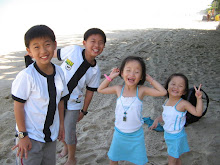
After the visit to the Charcoal factory (written in previous post), we proceed to the next destination: Hutan Paya Laut Matang.
Mangroves offer a different experience than rainforests.
The Matang mangrove forest is a good place for anyone to get a natural education. An easy side trip from Taiping, take the time to explore this coastal habitat that supports waterbirds, fisheries and charcoal production.
Boardwalks take you into the mangrove swamp for close observation of the forest structure. Boat rides along the river at night showoff the sparkling splendour of fireflies.
Visit large kilns where freshly harvested mangrove trees burn into charcoal (see pics in my previous post). Or ask the Forestry Department to provide a nature guide to explain how the mangrove ecosystem functions.
Mangroves are special habitats. They protect the shoreline from erosion and tsunamis, provide shelter from wind, provide habitat for fish and shellfish, serve as stopover sites for migratory birds, and provide natural medicines and wood products.
For over 100 years, the Matang mangrove forest have stood out as a premier example of Malaysia's sustainable forest management. Trees are harvested after 30 years and extracted only with wooden wheelbarrows.
Mangroves are not spectacular, but they are interesting in many ways:
* Watch Long-tailed macaques clamber about the boardwalk and mangled tree roots.

* Try to figure out why trees develop leg-like stilt roots and air-breathing roots.

* Practice your bird and plant photography skills amid the serene silence of the forest.
* Bring the group or class for an ecological education on the adaptations of mangroves.
Here are some of my snap shots I took when I was there with my family of few adults and 9 kids:




Some facts to share:
Matang Mangrove Forest is one of the world's best managed Mangrove Forest.
This mangrove swamp should be one of the main attractions for many visitors scheduled to Larut.
Covering an area of more than 40,000 hectares, it is recognised as one of the most well managed expanse of mangrove swamps in the world and Perak has received various international awards for it.
Within this mangrove swamp are found multitudes of tree species, birds and marine life which is a haven for nature lovers.
Being next to the sea, mangrove plants evolved to adapt to harsh conditions. On your next trip find and explain some of these marvelous modifications?
* Roots That Anchor -- To keep strong against water currents, cable-like roots buried in the mud grow deep to hold the trees steady.
* Roots That Breathe -- With trees submerged in water, hundreds of pencil-thick roots grow upwards to take in oxygen and avoid water.
* Leaves That Take Out Salt -- Living in salty sea water means that leaves must take out the extra salts for trees to grow.
* Fruit That Floats -- Fruits stay longer on the parent tree before dropping into the mud or have air-pockets to float until it reaches soft ground.
* Thick And Leathery Leaves -- To conserve water in hot and salty conditions, some species have thick or waxy leaves for protection.
For more info, please contact:
Matang District Forest Office
Matang
Jalan Muzium, 34000 Taiping, Perak
Tel: 05-807 2762/5324
Fax: 05-806 7743
Website: www.perak.gov.my
Email: phdlm@perak.gov.my






No comments:
Post a Comment